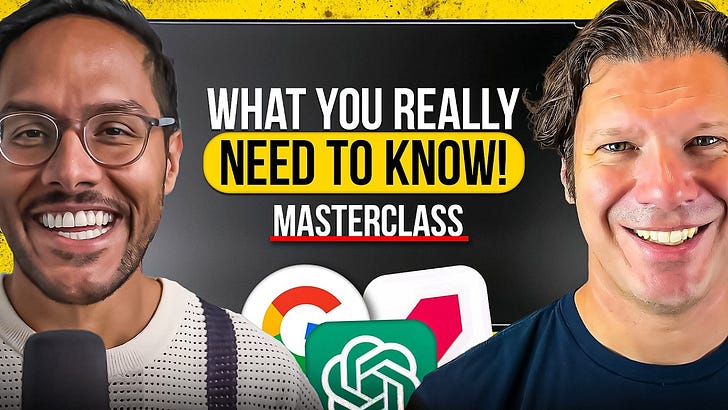Listen now on Apple, Spotify, and YouTube.
Brought to you by:
June.so: Customer analytics for product focused teams
Dovetail: The Fastest Way to Understand Your Customer
SectaLabs: Professional headshots from regular selfies
"Ship first, think later." "Tech doesn’t matter." "Users don’t have to be happy."
These are just a few of the controversial takes from Thibault Louis-Lucas, the creator of multiple SaaS hits that he sold for over $10M (Two sold to Lempire).
As I’ve often said, PMs and aspiring PMs can learn a lot from the scrappy, relentless mindset of indie hackers. Today’s episode is a masterclass in just that.
In this podcast, he pulls back the curtain on rapid product validation, the perils of building on third-party platforms, leveraging AI to slash development costs, and why distribution — not just the product itself —is the ultimate key to success.
Our Agenda:
Shipping 11 products before mega hits — 00:13:25
Selling TweetHunter and Taplio to Lempire for $8 million — 00:51:44
Why and how PMs should build with AI — 01:10:33
Criteria for deciding which ideas to build — 01:28:18
Pros and cons of building in public — 01:44:37
Here are the Key Takeaways
Here are 5 of Tibo’s most powerful insights:
1. Ship First, Think Later
This might be counterintuitive but speed beats perfection when validating ideas.
Instead of aiming for perfection, he focused on identifying solutions to specific, pressing issues faced by creators and solopreneurs and shipped 11 products in quick succession to find product-market fit.
With TweetHunter, the initial feature was incredibly simple: a curated feed of viral tweets designed to inspire users.
This resonated well with the audience, proving its value almost instantly.
Product managers need to take a similar approach by starting simple, shipping fast, and let the market shape your product with their needs.
2. Founder-Problem Fit Drives Success
Knowing the problem deeply often means knowing the solution too.
He targeted creators because he was one himself and experienced the same challenges firsthand.
He emphasised that surface-level customer discovery often leads to shallow solutions.
While building TweetHunter, His personal struggle to grow his Twitter audience informed the product’s focus on finding and repurposing old viral tweets.
Here’s what it means for you as a PM:
Become the user of your own product and figure out the gaps you can fill for unparalleled user experince.
Solving your own problems often leads to the most authentic and impactful solutions.
3. Monetization is the True Validation
Free users and positive feedback can be misleading.
The willingness of users to pay is the strongest signal of whether your product solves a genuine problem.
Tibo’s early product TweetButler garnered positive comments but failed to generate enough revenue.
But when he pivoted to TweetHunter and focusing more on daily pressing user problems not “nice-to-solve”, it gained real traction and paying customers.
Avoid relying on vanity metrics like sign-ups or free users. Instead, implement monetization early to gauge real demand.
If users aren’t paying, your product may not have achieved true market fit.
4. Building in Public Is Non-Negotiable
Building in public fosters transparency, trust, and an engaged community around your product.
Sharing your journey — successes, failures, and lessons— turns users to feel invested in your product’s growth and build a strong community.
Which not only validates your ideas but also becomes your most effective marketing channel by amplifying your message and attracting new users.
For example, by openly sharing his product-building process on Twitter, Tibo generated buzz for TweetHunter.
As a PM, develop your next feature in public by sharing regular updates, engaging your audience for feedback, and using surveys to uncover hidden pain points.
5. Strategic Influencer Partnerships is The Real Cheat Code
One of Tibo’s smartest moves was partnering with a well-known Twitter growth influencer, giving him a 25% equity stake in TweetHunter.
This partnership wasn’t just a promotional gimmick; it was built on clear expectations and complete transparency.
By collaborating with this influencer, he took TweetHunter from $3K to $20K in monthly revenue in just weeks.
Here’s how you can leverage it:
Look for influencers/ distribution platforms (Newsletters, etc) whose audience aligns with your target users.
Build a long term partnership and plan co-branded campaigns that leverage their platform, voice, and reach to maximize visibility and conversions.
For more details, listen to the full episode now!
Referenced
Strategy: "Law of Shitty Click-Throughs" by Andrew Chen — a foundational growth marketing concept that explains how initially effective techniques lose their potency as they get overused.
Tools:
Where to find Tibo
If you prefer to only get newsletter emails, unsubscribe from podcast emails here.
Up Next
We have some great podcasts coming from Melissa Perri, Colin Lernell, and Andrew Capland. I’m so excited to share them with all of you.
In the newsletter, check out this week’s latest piece if you haven’t yet: How to Move Geographies as a PM
And look out for these pieces up next:
How to Build an Empowered Team
How to Write an AI PM Resume
Onboarding Metrics: Advanced Topics and Practice
I think you’re going to love what’s coming up,
Aakash












